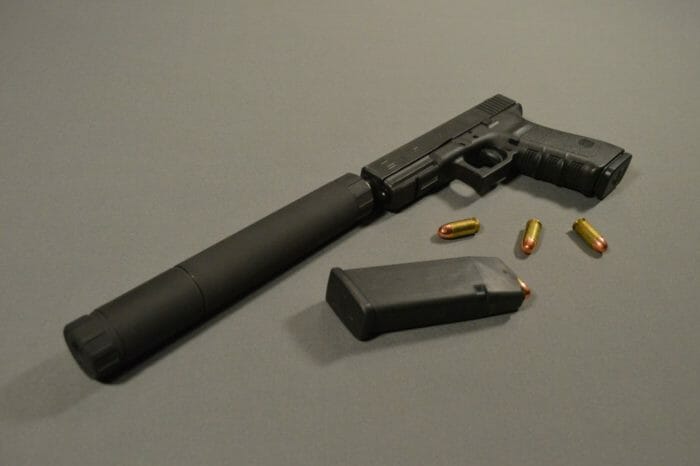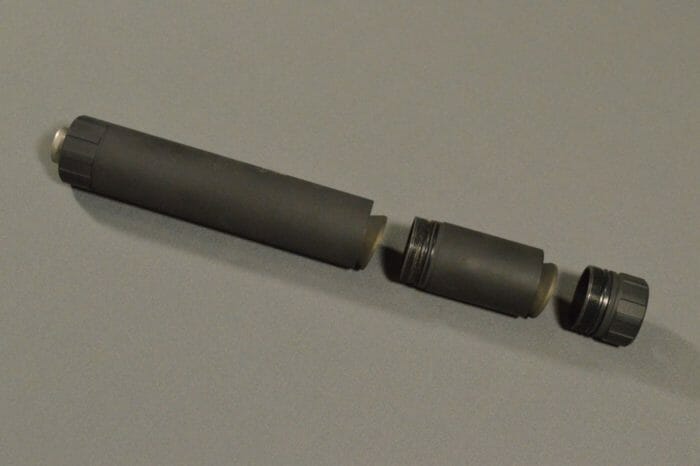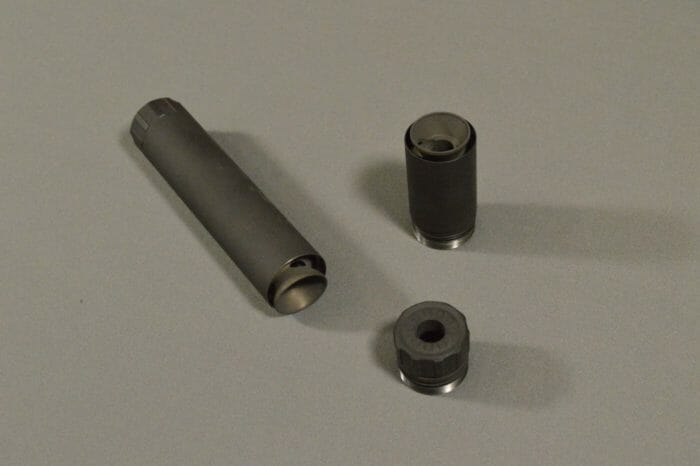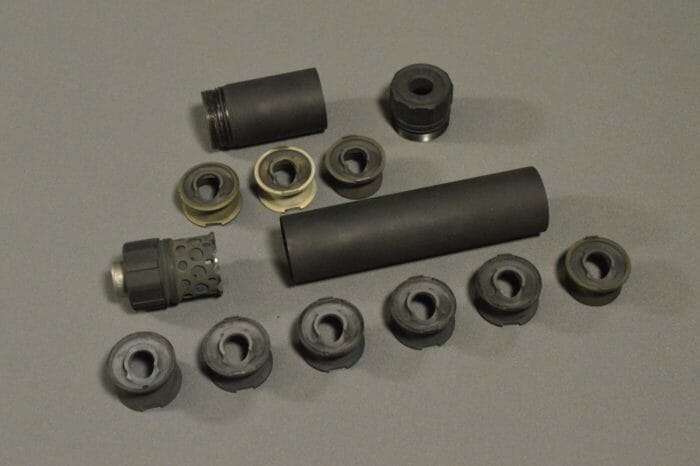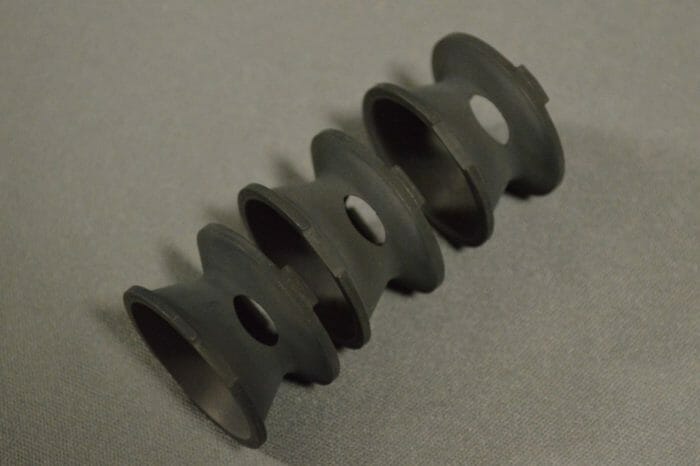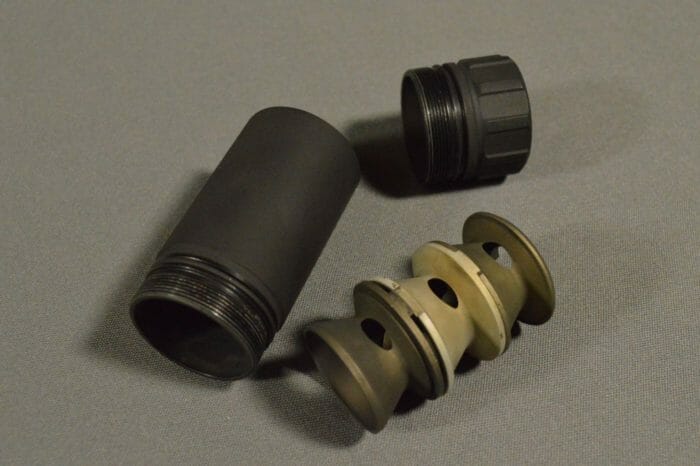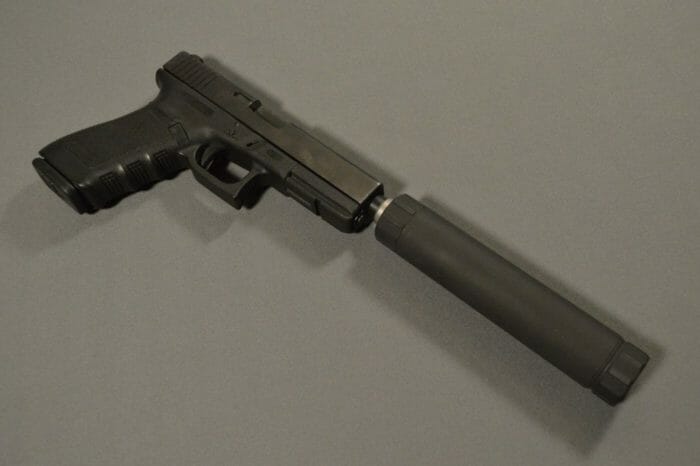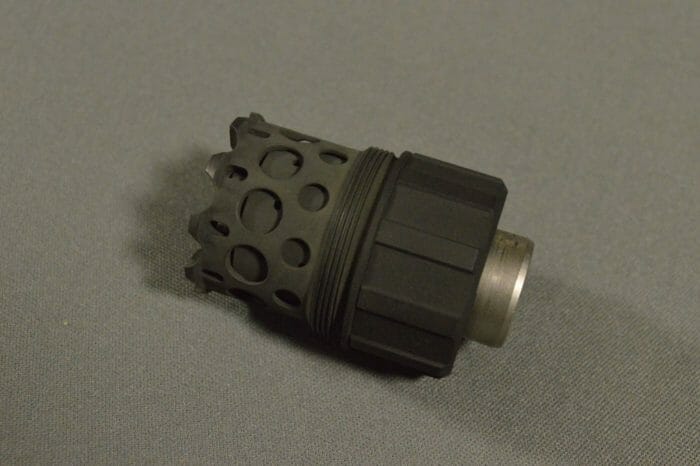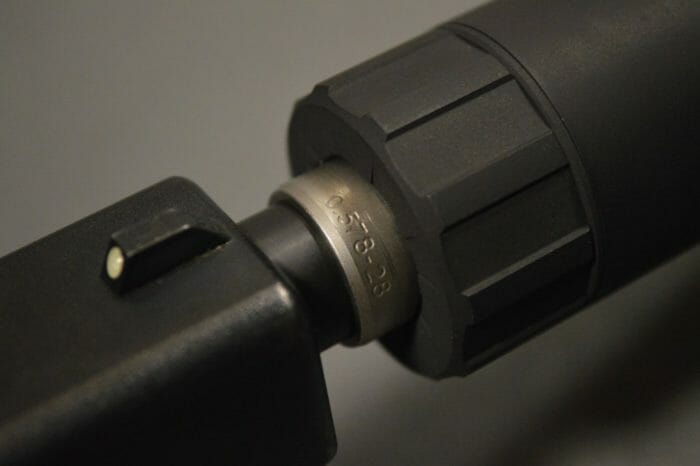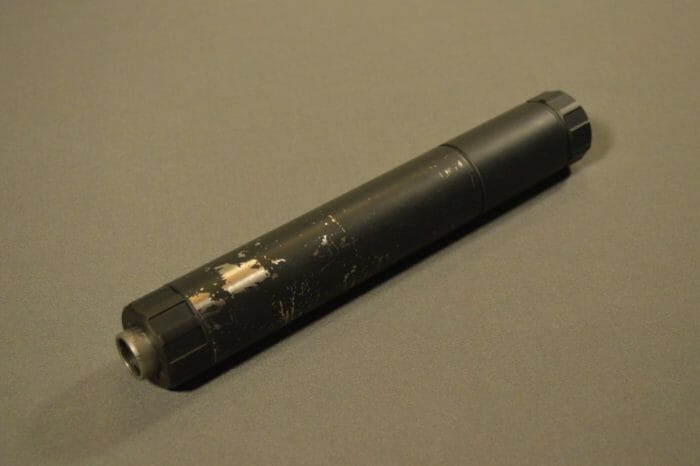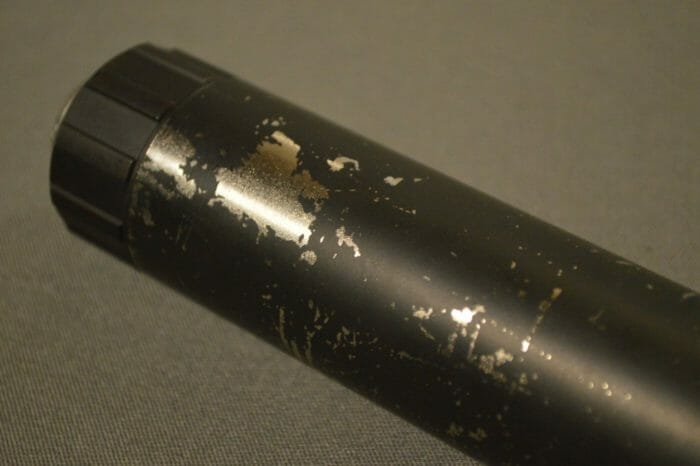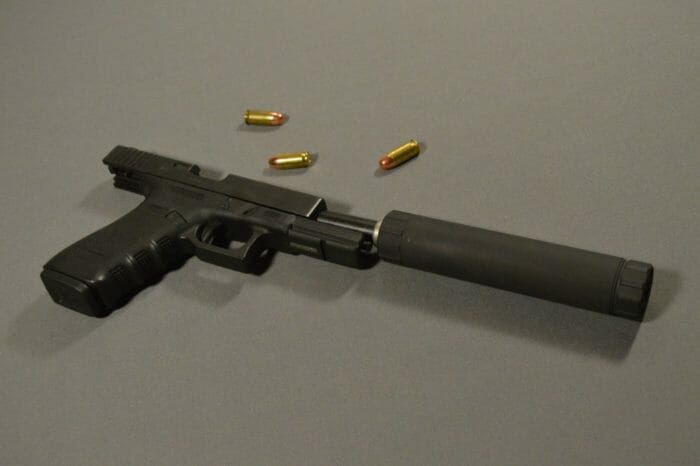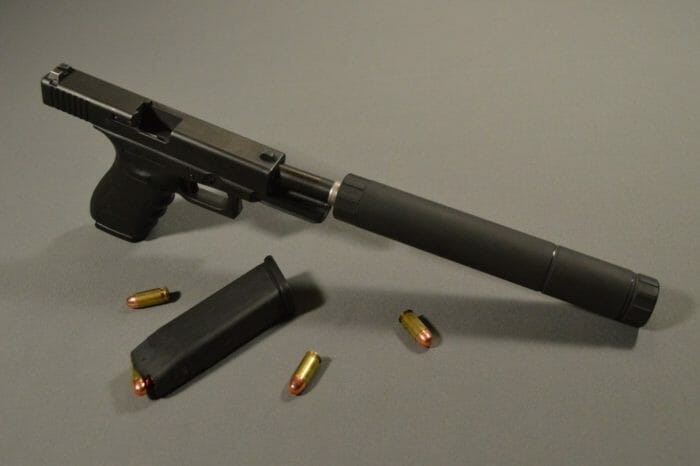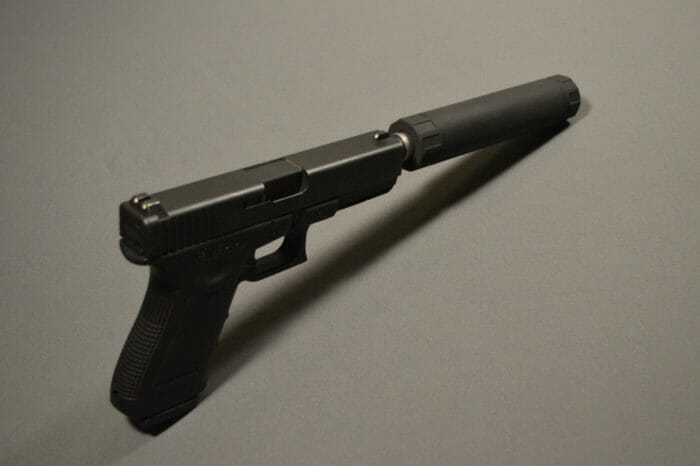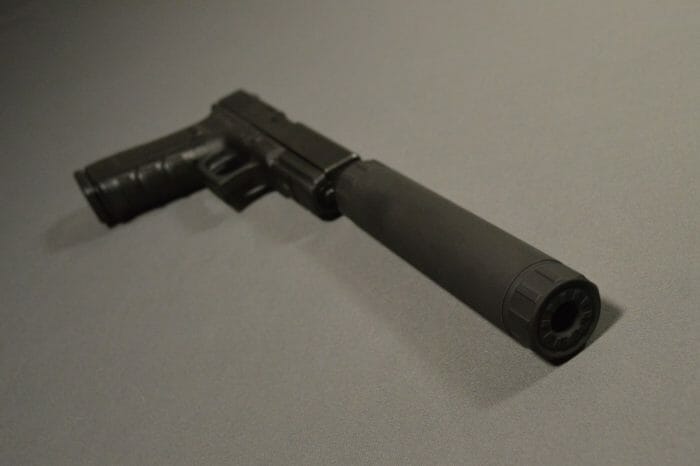Silencer Shop Authority: AAC Ti-Rant 45M Review
For me, AAC’s Ti-Rant series has always been analogous to that person that all of your friends know and love, but you’ve never met. The Ti-Rant 9 was, according to many, the quietest 9mm suppressor on the market for several years, and the short S-models are probably the most successful “K” cans available. Today, we will take a close look at the newest member of the family, the modular Ti-Rant 45M.
Size & Weight
In order to compete with other market leaders, AAC developed the Ti-Rant 45M as a modular pistol silencer with two configurable lengths. Its longest arrangement sits at 9″ long (including the piston), while the shorter format is just a hair under 7″. Though 9″ is quite long for a pistol suppressor, the 7″ configuration handles almost perfectly and at the range, I spent most of my time with the shortened Ti-Rant for that very reason.
The listed weights for the 45M can be somewhat deceiving. In the full-length configuration, AAC’s silencer weighs 12.3 ounces. Shortened, it drops to 10.5 ounces. Neither of these seems very light, but the numbers don’t tell the whole story. Compared to other designs, the Ti-Rant has a relatively hefty piston assembly/Nielsen device. This results in a nominally heavy suppressor, but because most of the baffles are aluminum, most of the silencer’s weight is loaded closer to the pistol/shooter. In short, the Ti-Rant’s favorable center of gravity makes it feel lighter than the raw numbers indicate.
Materials & Design
As the name implies, the Ti-Rant features a titanium main tube. Meanwhile, the front module saves a small amount of weight by being 7075 T6 aluminum. I’m not sure that titanium buys users much on a pistol suppressor, where aluminum would be a perfectly acceptable material, but AAC has nonetheless used it for several years.
Inside the Ti-Rant 45M sit nine K-style baffles. The can’s blast baffle is machined out of 17-4 stainless steel, for additional durability. Each of the distal baffles are 7075 T6 anodized aluminum and AAC has packed three of them into the Ti-Rant’s removable forward section. To assist with alignment during reassembly, most of the baffles are keyed.
Aluminum baffles are one of those things that many suppressor enthusiasts get worked up over. They shouldn’t be cleaned with aggressive agents, like ultrasonic tanks or solutions like the “dip” and Hoppes #9. However, it is also unlikely that most pistol ammunition will foul the can to the point that such drastic measures are needed. In the Ti-Rant’s case, I see no problem exchanging stainless baffles for reduced weight.
Taking the Ti-Rant apart is simple. The front module unscrews as a unit with the baffles retained so they won’t freely fall out. Unscrewing the end cap facilitates their removal. If you’re looking to simply shorten the can, the end cap can then be fastened the main tube. Otherwise, with the front module off, the baffles inside the silencer’s primary segment can be dumped through the front of the silencer.
Putting the Ti-Rant 45M back together is also very simple, but can trigger some folks’ OCD. If you save the end cap as the last part to tighten down, you may end up with a situation where it looks like it isn’t fastened all the way, but won’t go any further. The suppressor is perfectly fine to use like this, but it might make some people a little crazy. This “issue” exists because the Ti-Rant’s tube and end caps work together to sandwich the baffles in place.
To keep myself sane, I placed both end caps on their respective tubes prior to attaching the front module to the 45M’s main tube. This ensures that the thread spacing is properly set for both caps, and the joint between the two tube segments has an o-ring – making it much more flexible from a spacing perspective.
Owners of past-generation Ti-Rants will be happy to know that the 45M uses the same pistons employed by its 9mm and .45 ACP predecessors. I neglected to photograph the 45M’s piston, but rest assured it is the same. Beyond backward compatibility, recycling the original Ti-Rant piston design means that plenty of parts are out there, and newcomers to the line won’t need to wait for required thread pitches. The example Silencer Shop sent me included a .578-28 piston that fits perfectly on my Glock 21’s Lone Wolf barrel.
The Ti-Rant does have one glaring weakness: its finish. Since the main body of the silencer is made of titanium, anodizing isn’t an option (at least if you want it to match the aluminum module). Instead, AAC has elected to use a Cerakote painted finish on the suppressor, and in all honesty, it isn’t very durable. The sample that Silencer Shop sent me for review had not been abused, yet much of the finish (especially on the main titanium tube) had chipped away. In order to have representative photos of a new Ti-Rant, I refinished the silencer using high-temperature grill enamel, but I did capture a few shots of the can as I received it. Cerakote is generally a respected finish, so I’m not quite sure where AAC went wrong here.
Range Report
For whatever reason, when people talk about modular pistol silencers, the Ti-Rant 45M usually gets left out. More often, you hear Dead Air’s Ghost, Griffin’s Revolution series or Rugged’s Obsidian tossed around as the preferred options and top performers in the category, and deservedly so. These alternatives are all excellent suppressors and are very well designed. However, it would be a mistake to forget that the original Ti-Rant series suppressors were possibly the quietest pistol caliber options for several years. With this kind of pedigree, the 45M gives up nothing to its competition.
Since the 45M is an adaptable suppressor, I was eager to try it in its short configuration. Mounted on my Glock 21SF, the can sounded phenomenal. At the same time I was testing the Ti-Rant, I was also checking out Rugged’s Obsidian 45. While the Obsidian may technically be quieter, the Ti-Rant sounded every bit as good. In fact, the 45M’s tone was slightly (but noticeably) deeper. Silencer Shop’s testing found the short 45M to hover in the 140 to 141 dB range both at ear and one meter from the muzzle. Technically, this is above the “hearing safe” threshold (140 dB), but I honestly found the short configuration to be perfectly usable without additional hearing protection. I’ve tested suppressors that offer similar at ear performance (at least from a numbers perspective) and I think the 45M sounded quieter than the meter indicates. Regardless, ear muffs or plugs are recommended for extended shooting, even with a suppressor.
In its long configuration, the 45M is just as impressive. Once again, using Silencer Shop’s numbers, the 130 dB Ti-Rant is a mere one dB louder than the category champ, the Obsidian 45. It also features less backpressure (at least on my Glock) than Rugged’s can. At the same time, the aluminum baffles keep the Ti-Rant from feeling overly heavy at the end of a full-size handgun.
Any time a suppressor falls within the “hearing safe” range, first-round pop (FRP) is bound to be more noticeable than it would be on louder hosts/less efficient cans. Speaking purely from a numbers perspective, the 45M has considerable FRP, which testing has shown to be in the seven to eight dB range. Without Silencer Shop’s testing work, I probably would have estimated that the first round through a freshly mounted 45M would come in approximately five dB louder than subsequent ones. In other words, FRP with the Ti-Rant is essentially on-par with other .45 ACP suppressors.
Conclusion
The Ti-Rant 45M is an underrated silencer. Considering the popularity of the original Ti-Rants, I am truly surprised I need to say it, but the 45M seems to have been overshadowed by other exciting cans that offer similar features. Certainly, AAC has plenty of room for improvement as far as finishes go and aluminum K-baffles might present cleaning concerns for some buyers. However, there is no denying that the 45M handles extremely well and offers performance that rivals category leaders.
Readers who are interested in purchasing a Ti-Rant 45M can find the silencer for as low as $628 at Silencer Shop. Actual pricing will vary by dealer.
An information security professional by day and gun blogger by night, Nathan started his firearms journey at 16 years old as a collector of C&R rifles. These days, you’re likely to find him shooting something a bit more modern – and usually equipped with a suppressor – but his passion for firearms with military heritage has never waned. Over the last five years, Nathan has written about a variety of firearms topics, including Second Amendment politics and gun and gear reviews. When he isn’t shooting or writing, Nathan nerds out over computers, 3D printing, and Star Wars.

